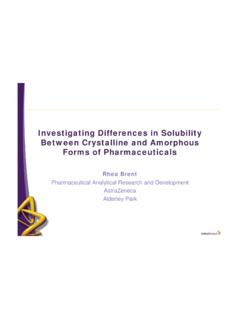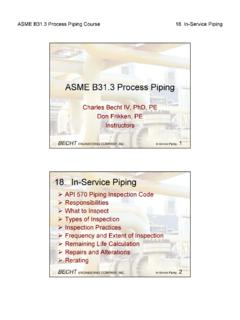Transcription of “Cooking with Chemicals” - Welcome to MMS …
1 EYP 2006 EYP 2006 Differential Scanning Differential Scanning CalorimetryCalorimetryClare RawlinsonClare RawlinsonSchool of PharmacySchool of PharmacyUniversity of BradfordUniversity of Bradford cooking with ChemicalsCooking with Chemicals EYP 2006 EYP 2006 OutlineOutline Brief history of thermal analysisBrief history of thermal analysis Theory of thermal analysis techniques Theory of thermal analysis techniques Thermal Gravimetric Analysis (TGA)Thermal Gravimetric Analysis (TGA) Differential Scanning Calorimetry (DSC)Differential Scanning Calorimetry (DSC) Generating valid dataGenerating valid data CalibrationCalibration Sample preparationSample preparation Interpreting data and ApplicationsInterpreting data and Applications Real eventsReal events ArtefactsArtefacts Recent advancesRecent advancesEYP 2006 EYP 2006 CalorimetryCalorimetry CalorimetryCalorimetry The study of heat transfer during The study of heat transfer during physical and chemical processesphysical and chemical processes CalorimeterCalorimeter A device for measuring the heat A device for measuring the heat transferredtransferredLavoisierLavoisier and and LaplaceLaplace(1782(1782--1784):1784).
2 Oil was burned in a lamp (oil was burned in a lamp (Fig 9 Fig 9) held in ) held in a bucket (Fig. 8) held in a wire mesh a bucket (Fig. 8) held in a wire mesh cage (cage (ff)) surrounded by ice in spaces surrounded by ice in spaces bband and aaof of the double walled container a foot in the double walled container a foot in diameterdiameter lid (lid (FF) was topped with ice, as was a ) was topped with ice, as was a mesh lid (not shown) beneath it that mesh lid (not shown) beneath it that covered the inner volume covered the inner volume bbEYP 2006 EYP 2006 Oil lamps to Guinea PigsOil lamps to Guinea Measured heat production of Measured heat production of the metabolic processes in the metabolic processes in the ice bath calorimeterthe ice bath calorimeter Outer jacket prevented Outer jacket prevented conduction of heat from the conduction of heat from the external environment which external environment which would have also melted the would have also melted the iceice From latent heat of fusion for From
3 Latent heat of fusion for ice (334 J/gram ice at 0 ice (334 J/gram ice at 0 C) C) LavoisierLavoisierconverted the rate converted the rate of water formation to heat of water formation to heat production production In 10 hours 370 grams of ice In 10 hours 370 grams of ice meltedmeltedGuinea pig produced 12,358 J per hour of heat Guinea pig produced 12,358 J per hour of heat ( kJ/hr)( kJ/hr)EYP 2006 EYP 2006 Basic Principles of Thermal AnalysisModern instrumentation used for thermal analysis usually consists of four parts: sample/sample holder sensors to detect/measure a property of the sample and the temperature an enclosure within which the experimental parameters may be controlled a computer to control data collection and processingEYP 2006 EYP 2006 TGA and DSCTGA and DSC Thermogravimetric Analysis (TGA)
4 Mass change of a substance measured as function of mass change of a substance measured as function of temperature whilst the substance is subjected to a controlled temperature whilst the substance is subjected to a controlled temperature programmetemperature programme11 mass is lost if the substance contains a volatile fractionmass is lost if the substance contains a volatile fraction Differential Scanning Calorimetry (DSC) provides information about thermal changes that do not involve aprovides information about thermal changes that do not involve achange in sample masschange in sample mass11 more commonly used technique than TGA more commonly used technique than TGA Two basic types of DSC instruments: heat-flux and power compensation1 Haines, P.
5 J. (2002) The Royal Society of Chemistry, 2006 EYP 2006 Sample holder : sample and reference are connected by a low-resistance heat flow path Aluminium, stainless, platinum sample pansSensors:Sensors: temperature sensorstemperature sensors usually thermocouplesusually thermocouplesFurnace: one block for both sample and reference cellsTemperature controller: temperature difference between the sample and reference is measuredHeat Flux DSCsamplepaninert gasvacuumheatingcoilreferencepanthermoco uplesEYP 2006 EYP 2006 Sample holderSample holder: : AluminiumAluminium, platinum, stainless steel pans, platinum, stainless steel pansSensors:Sensors: Pt resistance Pt resistance thermocouples.
6 Thermocouples. Separate sensors Separate sensors and heaters for theand heaters for thesample and referencesample and referenceFurnace:Furnace: separate blocks for sample and reference cellsseparate blocks for sample and reference cellsTemperature controller:Temperature controller: differential thermal power is supplied to the heaters to maintadifferential thermal power is supplied to the heaters to maintain the in the temperature of the sample and reference at the program valuetemperature of the sample and reference at the program valuesamplepan T = 0inert gasvacuuminert gasvacuumindividualheatersreferencepanth ermocouplePower Compensated DSCP ower Compensated DSCEYP 2006 EYP 2006 OutlineOutline Brief history of thermal analysisBrief history of thermal analysis Theory of thermal analysis techniques Theory of thermal analysis techniques Thermal Gravimetric Analysis (TGA)Thermal Gravimetric Analysis (TGA)
7 Differential Scanning Calorimetry (DSC)Differential Scanning Calorimetry (DSC) Generating valid dataGenerating valid data CalibrationCalibration Sample preparationSample preparation Interpreting data and ApplicationsInterpreting data and Applications Real eventsReal events ArtefactsArtefacts Recent advancesRecent advancesEYP 2006 EYP 2006 DSC CalibrationBaselineCalibration evaluation of the thermal resistance of the sample and reference sensors measurements over the temperature range of interestEYP 2006 EYP 2006 DSC Calibration Temperature match melting onset temperatures to the known melting points of standards analyzed by DSC should be calibrated as close to desired
8 Temperature range as possible Heat flow use calibration standards of known heat capacity, slow accurate heating rates ( C/min), and similar sample and reference pan weightscalibrants high purity accurately known enthalpies thermally stable light stable not hygroscopic do not react (pan, atmosphere)metals Indium C; J/g Zinc C, J/ginorganics C Corganics polystyrene 105 C benzoic acid C; J/gEYP 2006 EYP 2006 Sample Preparation accurately-weighed samples (~3-20 mg, usually 3-5 mg for simple powders) small sample pans ( mL) of inert or treated metals (Al, Pt, stainless) several pan configurations, , open , pinhole, or hermetically-sealed pans same material and configuration should be used for the sample and the reference material should completely cover the bottom of the pan to ensure good thermal contact avoid overfilling the pan to minimize thermal lag from the bulk of the material to the sensorAlPtaluminaNiCuquartz* small sample masses and low heating rates increase resolution.
9 But at the expense of sensitivityEYP 2006 EYP 2006 Purge GasesPurge Gases Sample may react with air Sample may react with air --oxidising or burningoxidising or burning Control moisture content of atmosphereControl moisture content of atmosphere Use inert gas nitrogen or argonUse inert gas nitrogen or argon Flowing purge gasFlowing purge gas In some cases deliberately choose reactive gas, In some cases deliberately choose reactive gas, hydrogen to reduce an oxide to metalhydrogen to reduce an oxide to metal carbon dioxide which affects decomposition of metal carbonatecarbon dioxide which affects decomposition of metal carbonate Removes waste products from sublimation or Removes waste products from sublimation or decompositiondecompositionEYP 2006 EYP 2006 OutlineOutline Brief history of thermal analysisBrief history of thermal analysis Theory of thermal analysis techniques Theory of thermal analysis techniques Thermal Gravimetric Analysis (TGA)Thermal Gravimetric Analysis (TGA) Differential Scanning Calorimetry (DSC)Differential Scanning Calorimetry (DSC)
10 Generating valid dataGenerating valid data CalibrationCalibration Sample preparationSample preparation Interpreting data and ApplicationsInterpreting data and Applications Real eventsReal events ArtefactsArtefacts Recent advancesRecent advancesEYP 2006 EYP 2006 Typical Features of a DSC Trace (Polymorphic System)sulphapyridineendothermic eventsmeltingsublimationsolid-solid transitionsdesolvationchemical reactionsexothermic eventscrystallizationsolid-solid transitionsdecompositionchemical reactionsbaseline shiftsglass transitionExoEYP 2006 EYP 2006 Melting Processes by DSCPure substances linear melting curve melting point defined by onset temperatureeutectic meltMelting with decomposition exothermic endothermicImpure substances Broad.







